exam questions with answer ,class notes
EXCELLENT HOMEWORK HELP AND TUTORING ,ALL KIND OF QUIZ AND EXAMS WITH GUARANTEE OF A
Am an expert on major courses especially; psychology,Nursing, Human resource Management and Mathemtics Assisting students with quality work is my first priority. I ensure scholarly standards in my documents and that's why i'm one of the BEST GOLD RATED TUTORS in STUVIA. I assure a GOOD GRADE if you will use my work.
- 203
- 0
- 1
Community
- Followers
- Following
201 items
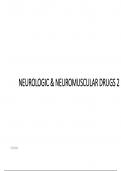
NEUROLOGIC & NEUROMUSCULAR DRUGS 2
NEUROLOGIC & NEUROMUSCULAR DRUGS 2 9/26/2024 Anticonvulsant drugs Anticonvulsant drugs inhibit neuromuscular transmission. They can be prescribed for: • long-term management of chronic epilepsy (recurrent seizures) • short-term management of acute isolated seizures not caused by epilepsy, such as seizures after trauma or brain surgery. In addition, some anticonvulsants are used in the emergency treatment of status epilepticus (a continuous seizure state). Try one, then another...
- Exam (elaborations)
- • 27 pages •
NEUROLOGIC & NEUROMUSCULAR DRUGS 2 9/26/2024 Anticonvulsant drugs Anticonvulsant drugs inhibit neuromuscular transmission. They can be prescribed for: • long-term management of chronic epilepsy (recurrent seizures) • short-term management of acute isolated seizures not caused by epilepsy, such as seizures after trauma or brain surgery. In addition, some anticonvulsants are used in the emergency treatment of status epilepticus (a continuous seizure state). Try one, then another...
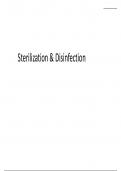
Sterilization & Disinfection
Sterilization & Disinfection Introduction • Sterilization is the killing or removal of all microorganisms, including bacterial spores, which are highly resistant. Sterilization is usually carried out by autoclaving, which consists of exposure to steam at 121°C under a pressure of 15 lb/in2 for 15 minutes. Surgical instruments that can be damaged by moist heat are usually sterilized by exposure to ethylene oxide gas, and most intravenous solutions are sterilized by filtration. ...
- Class notes
- • 14 pages •
Sterilization & Disinfection Introduction • Sterilization is the killing or removal of all microorganisms, including bacterial spores, which are highly resistant. Sterilization is usually carried out by autoclaving, which consists of exposure to steam at 121°C under a pressure of 15 lb/in2 for 15 minutes. Surgical instruments that can be damaged by moist heat are usually sterilized by exposure to ethylene oxide gas, and most intravenous solutions are sterilized by filtration. ...
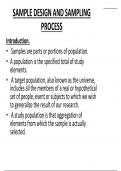
SAMPLE DESIGN AND SAMPLING PROCESS
SAMPLE DESIGN AND SAMPLING PROCESS Introduction. • Samples are parts or portions of population. • A population is the specified total of study elements. • A target population, also known as the universe, includes all the members of a real or hypothetical set of people, event or subjects to which we wish to generalize the result of our research. • A study population is that aggregation of elements from which the sample is actually selected. Cont’ • Sampling ...
- Class notes
- • 22 pages •
SAMPLE DESIGN AND SAMPLING PROCESS Introduction. • Samples are parts or portions of population. • A population is the specified total of study elements. • A target population, also known as the universe, includes all the members of a real or hypothetical set of people, event or subjects to which we wish to generalize the result of our research. • A study population is that aggregation of elements from which the sample is actually selected. Cont’ • Sampling ...
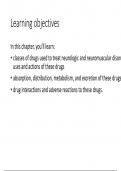
neurologic and neuromuscular disorders
Learning objectives In this chapter, you’ll learn: • classes of drugs used to treat neurologic and neuromuscular disorders uses and actions of these drugs • absorption, distribution, metabolism, and excretion of these drugs • drug interactions and adverse reactions to these drugs. The neurologic, or nervous, system includes the central nervous system (brain and spinal cord) and the peripheral nervous system (somatic and autonomic nervous systems). The neuromuscular syste...
- Class notes
- • 49 pages •
Learning objectives In this chapter, you’ll learn: • classes of drugs used to treat neurologic and neuromuscular disorders uses and actions of these drugs • absorption, distribution, metabolism, and excretion of these drugs • drug interactions and adverse reactions to these drugs. The neurologic, or nervous, system includes the central nervous system (brain and spinal cord) and the peripheral nervous system (somatic and autonomic nervous systems). The neuromuscular syste...
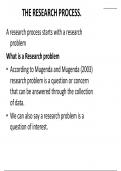
THE RESEARCH PROCESS.
THE RESEARCH PROCESS. A research process starts with a research problem What is a Research problem • According to Mugenda and Mugenda (2003) research problem is a question or concern that can be answered through the collection of data. • We can also say a research problem is a question of interest. Problem identification and formulation • The first step in the research development process is the problem identification. • First it involves indentifying the broad...
- Class notes
- • 23 pages •
THE RESEARCH PROCESS. A research process starts with a research problem What is a Research problem • According to Mugenda and Mugenda (2003) research problem is a question or concern that can be answered through the collection of data. • We can also say a research problem is a question of interest. Problem identification and formulation • The first step in the research development process is the problem identification. • First it involves indentifying the broad...
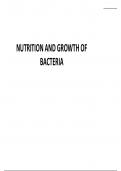
NUTRITION AND GROWTH OF BACTERIA NUTRITION AND GROWTH OF BACTERIA GROWTH CYCLE • Bacteria reproduce by binary fission, a process by which one parent cell divides to form two progeny cells. Because one cell gives rise to two progeny cells, bacteria ar
NUTRITION AND GROWTH OF BACTERIA NUTRITION AND GROWTH OF BACTERIA GROWTH CYCLE • Bacteria reproduce by binary fission, a process by which one parent cell divides to form two progeny cells. Because one cell gives rise to two progeny cells, bacteria are said to undergo exponential growth (logarithmic growth). The concept of exponential growth can be illustrated by the following relationship:Thus, 1 bacterium will produce 16 bacteria after 4 generations. • The doubling (gener...
- Class notes
- • 19 pages •
NUTRITION AND GROWTH OF BACTERIA NUTRITION AND GROWTH OF BACTERIA GROWTH CYCLE • Bacteria reproduce by binary fission, a process by which one parent cell divides to form two progeny cells. Because one cell gives rise to two progeny cells, bacteria are said to undergo exponential growth (logarithmic growth). The concept of exponential growth can be illustrated by the following relationship:Thus, 1 bacterium will produce 16 bacteria after 4 generations. • The doubling (gener...
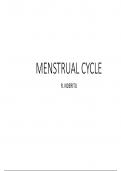
MENSTRUAL CYCLE R. NDERITU OVARIAN CYCLE 200,000 primordial follicles at birth in cortex of the ovary. Some of these become cystic Graafian follicle. Graafian follicle from puberty enlarges and one matures every month to give out an ovum. GRAA
MENSTRUAL CYCLE R. NDERITU OVARIAN CYCLE 200,000 primordial follicles at birth in cortex of the ovary. Some of these become cystic Graafian follicle. Graafian follicle from puberty enlarges and one matures every month to give out an ovum. GRAAFIAN FOLLICLE Ovum is situated at one end of Graafian follicle, encircled by narrow perivitelline space. Surrounding this are clump of cells discus cells radiate outward to form corona most cells of corona are very cle...
- Class notes
- • 21 pages •
MENSTRUAL CYCLE R. NDERITU OVARIAN CYCLE 200,000 primordial follicles at birth in cortex of the ovary. Some of these become cystic Graafian follicle. Graafian follicle from puberty enlarges and one matures every month to give out an ovum. GRAAFIAN FOLLICLE Ovum is situated at one end of Graafian follicle, encircled by narrow perivitelline space. Surrounding this are clump of cells discus cells radiate outward to form corona most cells of corona are very cle...
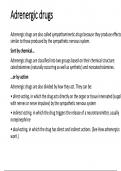
Adrenergic drugs Adrenergic drugs are also called sympathomimetic drugs because they produce effects similar to those produced by the sympathetic nervous system. Sort by chemical… Adrenergic drugs are classified into two groups based on their chemical
Adrenergic drugs Adrenergic drugs are also called sympathomimetic drugs because they produce effects similar to those produced by the sympathetic nervous system. Sort by chemical… Adrenergic drugs are classified into two groups based on their chemical structure: catecholamines (naturally occurring as well as synthetic) and noncatecholamines. …or by action Adrenergic drugs are also divided by how they act. They can be: • direct-acting, in which the drug acts directly on the ...
- Class notes
- • 41 pages •
Adrenergic drugs Adrenergic drugs are also called sympathomimetic drugs because they produce effects similar to those produced by the sympathetic nervous system. Sort by chemical… Adrenergic drugs are classified into two groups based on their chemical structure: catecholamines (naturally occurring as well as synthetic) and noncatecholamines. …or by action Adrenergic drugs are also divided by how they act. They can be: • direct-acting, in which the drug acts directly on the ...
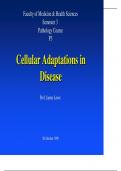
Faculty of Medicine & Health Sciences Semester 3 Pathology Course P3 Cellular Adaptations in Disease Prof. James Lowe 5th October 1999 Cellular adaptations in disease Overview Adaptability of cells to an altered environment Physiological
Faculty of Medicine & Health Sciences Semester 3 Pathology Course P3 Cellular Adaptations in Disease Prof. James Lowe 5th October 1999 Cellular adaptations in disease Overview Adaptability of cells to an altered environment Physiological and pathological stimuli Changes in growth pattern Hyperplasia, hypertrophy, atrophy, involution, metaplasia Apoptosis Growth factors Role in altered environment Faculty of Medicine &...
- Class notes
- • 44 pages •
Faculty of Medicine & Health Sciences Semester 3 Pathology Course P3 Cellular Adaptations in Disease Prof. James Lowe 5th October 1999 Cellular adaptations in disease Overview Adaptability of cells to an altered environment Physiological and pathological stimuli Changes in growth pattern Hyperplasia, hypertrophy, atrophy, involution, metaplasia Apoptosis Growth factors Role in altered environment Faculty of Medicine &...
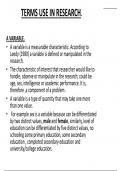
TERMS USE IN RESEARCH . A VARIABLE. • A variable is a measurable characteristic. According to Leedy (1980) a variable is defined or manipulated in the research. • The characteristic of interest that researcher would like to handle, observe or manip
TERMS USE IN RESEARCH . A VARIABLE. • A variable is a measurable characteristic. According to Leedy (1980) a variable is defined or manipulated in the research. • The characteristic of interest that researcher would like to handle, observe or manipulate in the research; could be age, sex, intelligence or academic performance. It is, therefore ,a component of a problem . • A variable is a type of quantity that may take one more than one value. • For example sex is ...
- Class notes
- • 19 pages •
TERMS USE IN RESEARCH . A VARIABLE. • A variable is a measurable characteristic. According to Leedy (1980) a variable is defined or manipulated in the research. • The characteristic of interest that researcher would like to handle, observe or manipulate in the research; could be age, sex, intelligence or academic performance. It is, therefore ,a component of a problem . • A variable is a type of quantity that may take one more than one value. • For example sex is ...
